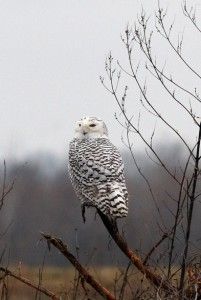Arctic owl swoops into southern Illinois

February 6, 2012
When she spotted a snowy owl sitting on a fencepost near Shawnee Community College, Karen Tharp said she did a double-take.
The large, almost all-white predatory bird usually lives in the frozen tundra of Canada, Alaska and Eurasia. The owl occasionally makes appearances in the northernmost contiguous United States, but is rarely seen as far south as southern Illinois.
Tharp, the volunteer coordinator for the Nature Conservancy in Illinois, said she always looks for animals on her morning drive to her office on the Shawnee Community College campus.
Advertisement
“That morning, I saw a pretty large white bird on the telephone pole that looked like an owl,” she said. “First I passed it, but then I turned around and drove back for a second look.”
She said when she realized that she was looking at a snowy owl, she drove as fast as she could to her office, grabbed a spotting scope and a camera and drove back to photograph the owl.
Tharp first spotted the snowy owl on Jan. 27. She said she notified the Southern Illinois Audubon Society, and members of the birding organization have been documenting the owl since that time.
Tony Gerard, a biology instructor at Shawnee Community College, said he was also able to photograph the owl. He said it was most likely a juvenile male because of its gray mottled feathers. Fully mature male snowy owls are almost pure white, he said.
Gerard said he believed Ullin was the southernmost place in Illinois a snowy owl had been spotted this year.
David Pitts, a biology professor and avian specialist at the University of Tennessee at Martin, said he made the nearly two-hour drive to southern Illinois as soon as he heard about the sighting.
He said the snowy owl is the most diurnal of all owls, feeding more frequently during the day than at night. They have a diverse diet of small rodents, fish and birds, he said, and have a life expectancy of about nine years in the wild.
Advertisement*
Pitts said the snowy owl may remain in the area for another month or two.
“Once they find a suitable feeding area, they will anchor there unless the food runs out,” he said.
Vicki Lang, vice president of the Southern Illinois Audubon Society, said she’s
also seen the owl.
“The snowy owl is a very large and heavy bird — bigger than you can imagine,” she said. “I could see it from more than a mile away.”
Lang said this is an irruptive year for the snowy owls, meaning a year when they winter outside their normal territory.
She said every few years there are sudden surges in the snowy owl population that may be triggered by increased numbers of lemmings, their favorite food. The owls produce more chicks when food is abundant, she said.
Some of these young are forced to leave the Arctic tundra in search of food when the lemming population returns to normal levels.
She said members of the Southern Illinois Audubon Society, knowing it was an irruptive year, has been watching for snowy owls since December. Another snowy owl had been spotted in Randolph County near Red Bud, she said.
Lang said the snowy owls like to be near waterways and open fields, making southernmost Illinois an ideal location for the bird.
Snowy owls that have travelled the long distance from the Arctic arrive exhausted and hungry, she said.
“This owl is likely to be in a compromised state,” Lang said.
She said people who want to see the owl should do so from a distance to avoid scaring it.
The snowy owl has attracted bird watchers from other states. On Saturday, Bala Chennupati, a bird enthusiast from Huntsville, Ala., drove five hours hoping for a chance to photograph the area’s rare visitor.
He said he saw the bird sitting on the ground in a large open field, and he was able to get close enough to take some good pictures.
“This was a once in a lifetime opportunity,”
he said.
Advertisement







